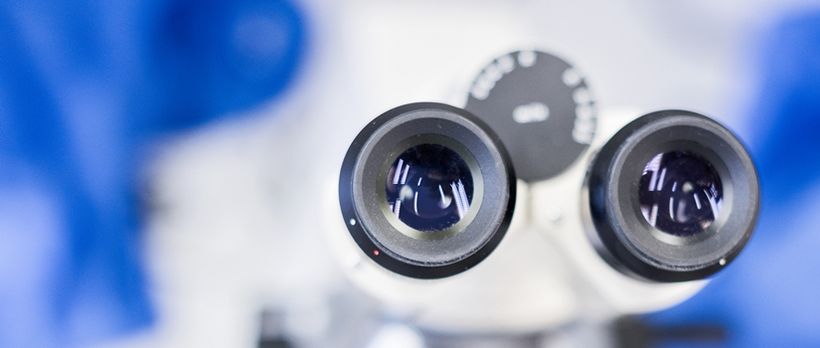Research foci Cell and Gene Therapy

Hereditary liver diseases
The scientists of the Guest Research Group “Cell- and Gene Therapy” currently study cell- and gene based methods to correct hereditary liver diseases. Protocols have been developed to generate hepatocytes from gene corrected induced pluripotent stem (iPS) cells or through direct reprogramming methods. Transplantation of those cells requires clinically applicable liver repopulation methods, which allow controlled ablation of endogenous hepatocytes and expansion of transplanted cells. The researchers currently test several promising methods to achieve liver repopulation and definitive correction of disease phenotypes. Another approach focuses on direct in vivo genome editing of disease causing genes by CRISPR-CAS-9 based methods in combination with homologous recombination. The group has developed an “all in one” AAV based vector for in vivo correction of the liver phenotype in mice with hereditary tyrosinemia. For transient therapy of urea cycle defects we develop RNA based gene correction in combination with non-viral delivery systems.
Funding:
DFG OT131/6-1 and DFG OT131/6-2
Publications
Chimeric livers for organ transplantation
The research group currently studies feasibility of generating of chimeric livers in rats and pigs for organ transplantation in patients with endstage liver diseases. Blastocyst injection of iPS cells results in low grade chimerism in “offspring” animals with a high degree of iPS derived hepatocytes in the liver, if a cellular niche is provided. In a rat model chimeric livers will then be transplanted into a disparate host animal. They will study cellular adaption and immunological acceptance of the transplanted organ in the absence of immunosuppression. Pigs with a liver niche, which allows a high degree of hepatocellular chimerism, have been generated in cooperation with the Institut für Nutztiergenetik (FLI) in Mariensee. The generation of monkey / pig liver chimeras is planned as “proof of principle” studies for human applications.
Funding:
DFG-Koselleck: 131/7-1-3013879
Novel Therapies for Hepatocellular Carcinoma
Hepatocellular carcinoma (HCC) is the most common type of liver cancer. HCCs are largely unresponsive towards most existing therapeutics. There is thus an urgent need for the development of novel and more effective treatments. A class of small (~22 nucleotide) non-coding RNAs called microRNAs (miRNAs) is deregulated in a number of human cancers including HCCs. These miRNAs are emerging as promising therapeutic targets. Despite the enormous potential of miRNAs as therapeutics, the biological function of individual cancer-associated miRNAs is only just emerging. The group focuses on the identification of novel miRNAs involved in HCC to understand their function in HCC development and to determine their therapeutic potential in HCC.
Funding
Deutsche Krebshilfe 111147
Publications
Therapies for Chronic Liver Diseases
In chronic liver diseases such as hepatitis B or C virus infections, hepatic stellate cells are activated and converted into myofibroblasts. The production of extracellular matrix proteins leads to fibrosis and scarring of the liver. Technologies that are intended to reduce the number of myofibroblasts or their activation status would therefore be useful for the therapy of liver fibrosis and cirrhosis. We recently showed that the targeted expression of four transcription factors in vivo could convert hepatic myofibroblasts into hepatocytes. The reduction in myofibroblast numbers and de novo generation of hepatocytes improved liver fibrosis in mice. The next efforts will focus on non-viral and non-DNA methods to reach and reprogram the myofibroblast population in the liver. The group discovered a novel peptide, GDF-11, which is expressed by myofibroblasts in chronic liver disease and stimulates progenitor cell proliferation. Over-expression of GDF-11 resulted in amelioration of fibrosis. GDF-11 could thus be developed as therapy for patients with endstage chronic liver disease. In addition, multiple microRNAs were tested for their therapeutic role in chronic liver disease.
Funding:
BMBF, DFG, Bill and Melinda Gates Foundation
Publications
Hereditary liver diseasesr
Krooss SA, Dai Z, Schmidt F, Rovai A, Fakhiri J, Dhingra A, Yuan Q, Yang T, Balakrishnan A, Steinbruck L, Srivaratharajan S, Manns MP, Schambach A, Grimm D, Bohne J, Sharma AD, Buning H, Ott M (2020) Ex Vivo/In vivo Gene Editing in Hepatocytes Using "All-in-One" CRISPR-Adeno-Associated Virus Vectors with a Self-Linearizing Repair Template. iScience 23(1): 100764.
Cantz T, Sharma AD, Ott M (2014) Concise Review: Cell therapies for hereditary metabolic liver diseases - concepts, clinical results and future developments. Stem Cells. doi: 10.1002/stem.1920
Novel Therapies for Hepatocellular Carcinoma
Komoll R, Hu Q, Olarewaju O, von Döhlen L, Yuan Q, Xie Y, Tsay HC, Daon J, Qin R, Manns MP, Sharma AD, Goga A, Ott M, Balakrishnan A (2020) MicroRNA-342-3p is a regulator of hepatocellular carcinoma regression. J Hepatol (in press).
Therapies for chronic liver diseases
Song G, Pacher M, Balakrishnan A, Yuan Q, Tsay HC, Yang D, Reetz J, Brandes S, Dai Z, Putzer BM, Arauzo-Bravo MJ, Steinemann D, Luedde T, Schwabe RF, Manns MP, Scholer HR, Schambach A, Cantz T, Ott M*, Sharma AD* (2016) Direct Reprogramming of Hepatic Myofibroblasts into Hepatocytes In Vivo Attenuates Liver Fibrosis. Cell Stem Cell 18(6): 797-808. (*corresponding authors)
Dai Z, Song G, Balakrishnan A, Yang T, Yuan Q, Moebus S, Weiss AC, Bentler M, Zhu J, Shen X, Bantel H, Jaeckel E, Kispert A, Vogel A, Saborowski A, Buening H, Manns MP, Cantz T, Ott M*, Sharma AD* (2020) Growth differentiation factor 11 attenuates liver fibrosis via expansion of liver progenitor cells. Gut 69(6): 1004-1115. *contributed equally
